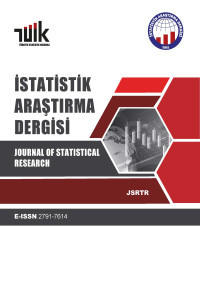Sıfır Değer Ağırlıklı Sayıma Dayalı Olarak Elde Edilen Bağımlı Değişkenin Modellenmesinde Kullanılan Regresyon Yöntemleri
Aşırı Yayılım, Negatif Binom Regresyonu, Poisson Regresyonu, Sıfır Ağırlıklı Negatif Binom Regresyonu, Sıfır Ağırlıklı Poisson Regresyonu
Regression Methods Used in Modelling of Dependent Variable Obtained Based on Zero-Inflated Count Data
Negative Binomial Regression, Overdispersion, Poisson Regression, Zero-Inflated Negative Binomial regression, Zero-Inflated Poisson Regression,
___
- Agresti, A., 1997. Categorical Data Analysis. New Jersey, Canada; John and Wiley & Sons, Incorporation.
- Böhning, D., 1994. A Note on a Test for Poisson Overdispersion. Biometrika, 81, 418-419.
- Böhning, D., 1998. Zero- Inflated Poisson Models and C.A.MAN: A Tutorial Collection of Evidence. Biometrical Journal, 40(7), 833-843.
- Böhning, D., Dietz, E ve Schlattmann, P., 1999. The Zero-Inflated Poisson Model and the Decayed, Missing and Filled Teeth Index in Dental Epidemiology. Journal of Royal Statistical Society, A, 162, 195–209.
- Breslow, N., 1990. Tests of Hypotheses in Overdispersed Poisson Regression and Other Quasi-Likelihood Models. Journal of American Statistical Association, 85(410), 565-571.
- Cameron, A.C ve Trivedi, P.K., 1998. Regression Analysis of Count Data. New York: Cambridge University Pres.
- Cheung, Y.B., 2002. Zero-Inflated Models for Regression Analysis of Count Data: A Study of Growth and Development. Statistics in Medicine, 21, 1461-1469.
- Cox, R., 1983. Some Remarks on Overdispersion. Biometrika,70, 269-274.
- Dalrymple, M.L., Hudson, I.L ve Ford, R.P.K., 2003. Finite Mixture, Zero-Inflated Poisson and Hurdle Models with Application to SIDS. Computational Statistics & Data Analysis 41, 491-504.
- Frome, E.D., Kutner, M.H ve Beauchamp, J.J., 1973. Regression Analysis of Poisson-Distributed Data. Journal of American Statistical Association, 68(344), 935-940.
- Hall, D.A., 2000. Zero-Inflated Poisson and Negative Binomial Regression with Random Effects: A Case Study. Biometrics, 56, 1030-1039.
- Kasap, İ., 2004. Effect of Different Apple Cultivars and of Temperatures on Biology and Life Table Parameters of TwoSpotted Spider Mite, Tetranychus Urticae Koch (Acarina: Tetranychidae). Phytoparasitica, 32(1): 73-82.
- Lambert, D., 1992. Zero-Inflated Poisson Regression, with an Application to Defects in Mnaufacturin. Technometrics, 34(1), 1-13.
- Lawles, J.F., 1987. Negative Binomial and Mixed Poisson Regression. The Canadian Journal of Statistcs, 15(3), 209-225.
- Lee, A.H ve Wang, K., 2001. Analysis of Zero-Inflated Poisson Data Incorporating Extent of Exposure. Biometrical Journal, 43(8), 963-975.
- McCullagh, P ve Nelder, J.A., 1989. Generalized Linear Models. Second Edition, London, UK, Chapmann and Hall.
- Muthen, L.K ve Muthen, B., 2002. MPlus: User’s Guide. Los Angeles, CA: Muthén & Muthén.
- Nelder, J.A ve Wedderburn, R.W.M., 1972. Generalized Linear Models. Journal of Royal Statistical Society A, 135(3), 370- 384.
- Ridout, M., Hinde, J ve Demetrio, C.G.B., 2001. A Score Test for a Zero-Inflated Poisson Regression Model Against Zero-Inflated Negative Binomial Alteratves. Biometrics, 57, 219-233.
- SAS., 2007. SAS/Stat. Software. Hangen and Enhanced, USA: SAS, Institute. Incorporation.
- Stokes, M.E., Davis, C.S ve Koch, G.G., 2000. Categorical Data Analysis Using the SAS System. USA; John and Wiley & Sons, Incorporation.
- Yau, K.K.W ve Lee, A.H., 2001. Zero-Inflated Poisson Regression with Random Effects to Evaluate an Occupational Injury Prevention Programme. Statistics in Medicine, 20, 2907-2920.
- ISSN: 1303-6319
- Başlangıç: 2002
- Yayıncı: TÜİK
Yaş Sınıflarının Doğurganlık Değeri Üzerindeki Etki Payları
Büyüme Eğrilerinin Eşitliğinde Permütasyon Testi
Abdullah YEŞİLOVA, Barış KAKİ, İsmail KASAP
Türkiye’de Bölgesel Farklılıkların Kırsal Ölçekte Analizi
Mehmet GÜRBÜZ, Murat KARABULUT, Ersin Kaya SANDAL
Kategorik Verilere Faktör Analizinin Uygulanması
Mevlüt TÜRE, İmran KURT, Hülya TÜRE
Behrens-Fisher Problemi ve Çözüm Yöntemleri
Mevsimsel Kesirli Bütünleşik Akgürültü Sürecinde Otokorelasyonlu Regresyon Yöntemi
Satın Alma Gücü Paritesinin Uzun Dönemde Geçerliliğinin Panel Birim Kök Testleri ile Sınanması
Kappa Katsayısının En Çok Olabilirlik Tahmin Edicisinin Simülasyon Çalışmasına Dayalı Elde Edilmesi
Çoklu Regresyon Uçdeğerlerinin Teşhisçisi Olarak Çanta Çiziti
